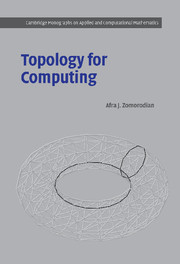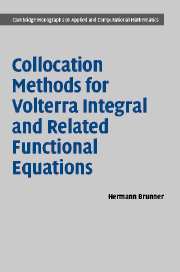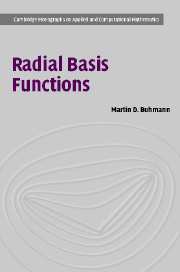Refine search
Actions for selected content:
2584 results in Computational Science

Topology for Computing
-
- Published online:
- 19 August 2009
- Print publication:
- 10 January 2005

Collocation Methods for Volterra Integral and Related Functional Differential Equations
-
- Published online:
- 17 August 2009
- Print publication:
- 15 November 2004

Radial Basis Functions
- Theory and Implementations
-
- Published online:
- 14 August 2009
- Print publication:
- 03 July 2003
7 - Singular learning machines
-
- Book:
- Algebraic Geometry and Statistical Learning Theory
- Published online:
- 10 January 2011
- Print publication:
- 13 August 2009, pp 217-248
-
- Chapter
- Export citation
6 - Singular learning theory
-
- Book:
- Algebraic Geometry and Statistical Learning Theory
- Published online:
- 10 January 2011
- Print publication:
- 13 August 2009, pp 158-216
-
- Chapter
- Export citation
4 - Zeta function and singular integral
-
- Book:
- Algebraic Geometry and Statistical Learning Theory
- Published online:
- 10 January 2011
- Print publication:
- 13 August 2009, pp 105-132
-
- Chapter
- Export citation
Bibliography
-
- Book:
- Algebraic Geometry and Statistical Learning Theory
- Published online:
- 10 January 2011
- Print publication:
- 13 August 2009, pp 277-283
-
- Chapter
- Export citation
3 - Algebraic geometry
-
- Book:
- Algebraic Geometry and Statistical Learning Theory
- Published online:
- 10 January 2011
- Print publication:
- 13 August 2009, pp 77-104
-
- Chapter
- Export citation
Contents
-
- Book:
- Algebraic Geometry and Statistical Learning Theory
- Published online:
- 10 January 2011
- Print publication:
- 13 August 2009, pp v-vi
-
- Chapter
- Export citation
Index
-
- Book:
- Algebraic Geometry and Statistical Learning Theory
- Published online:
- 10 January 2011
- Print publication:
- 13 August 2009, pp 284-286
-
- Chapter
- Export citation
2 - Singularity theory
-
- Book:
- Algebraic Geometry and Statistical Learning Theory
- Published online:
- 10 January 2011
- Print publication:
- 13 August 2009, pp 48-76
-
- Chapter
- Export citation
5 - Empirical processes
-
- Book:
- Algebraic Geometry and Statistical Learning Theory
- Published online:
- 10 January 2011
- Print publication:
- 13 August 2009, pp 133-157
-
- Chapter
- Export citation
Frontmatter
-
- Book:
- Algebraic Geometry and Statistical Learning Theory
- Published online:
- 10 January 2011
- Print publication:
- 13 August 2009, pp i-iv
-
- Chapter
- Export citation
1 - Introduction
-
- Book:
- Algebraic Geometry and Statistical Learning Theory
- Published online:
- 10 January 2011
- Print publication:
- 13 August 2009, pp 1-47
-
- Chapter
- Export citation
Preface
-
- Book:
- Algebraic Geometry and Statistical Learning Theory
- Published online:
- 10 January 2011
- Print publication:
- 13 August 2009, pp vii-viii
-
- Chapter
- Export citation
8 - Singular statistics
-
- Book:
- Algebraic Geometry and Statistical Learning Theory
- Published online:
- 10 January 2011
- Print publication:
- 13 August 2009, pp 249-276
-
- Chapter
- Export citation
Index of subjects
-
- Book:
- Exact and Approximate Controllability for Distributed Parameter Systems
- Published online:
- 04 August 2010
- Print publication:
- 20 March 2008, pp 454-458
-
- Chapter
- Export citation
References
-
- Book:
- Exact and Approximate Controllability for Distributed Parameter Systems
- Published online:
- 04 August 2010
- Print publication:
- 20 March 2008, pp 430-449
-
- Chapter
- Export citation
Frontmatter
-
- Book:
- Exact and Approximate Controllability for Distributed Parameter Systems
- Published online:
- 04 August 2010
- Print publication:
- 20 March 2008, pp i-vi
-
- Chapter
- Export citation
8 - Other wave and vibration problems. Coupled systems
- from Part II - Wave Models
-
- Book:
- Exact and Approximate Controllability for Distributed Parameter Systems
- Published online:
- 04 August 2010
- Print publication:
- 20 March 2008, pp 356-368
-
- Chapter
- Export citation
